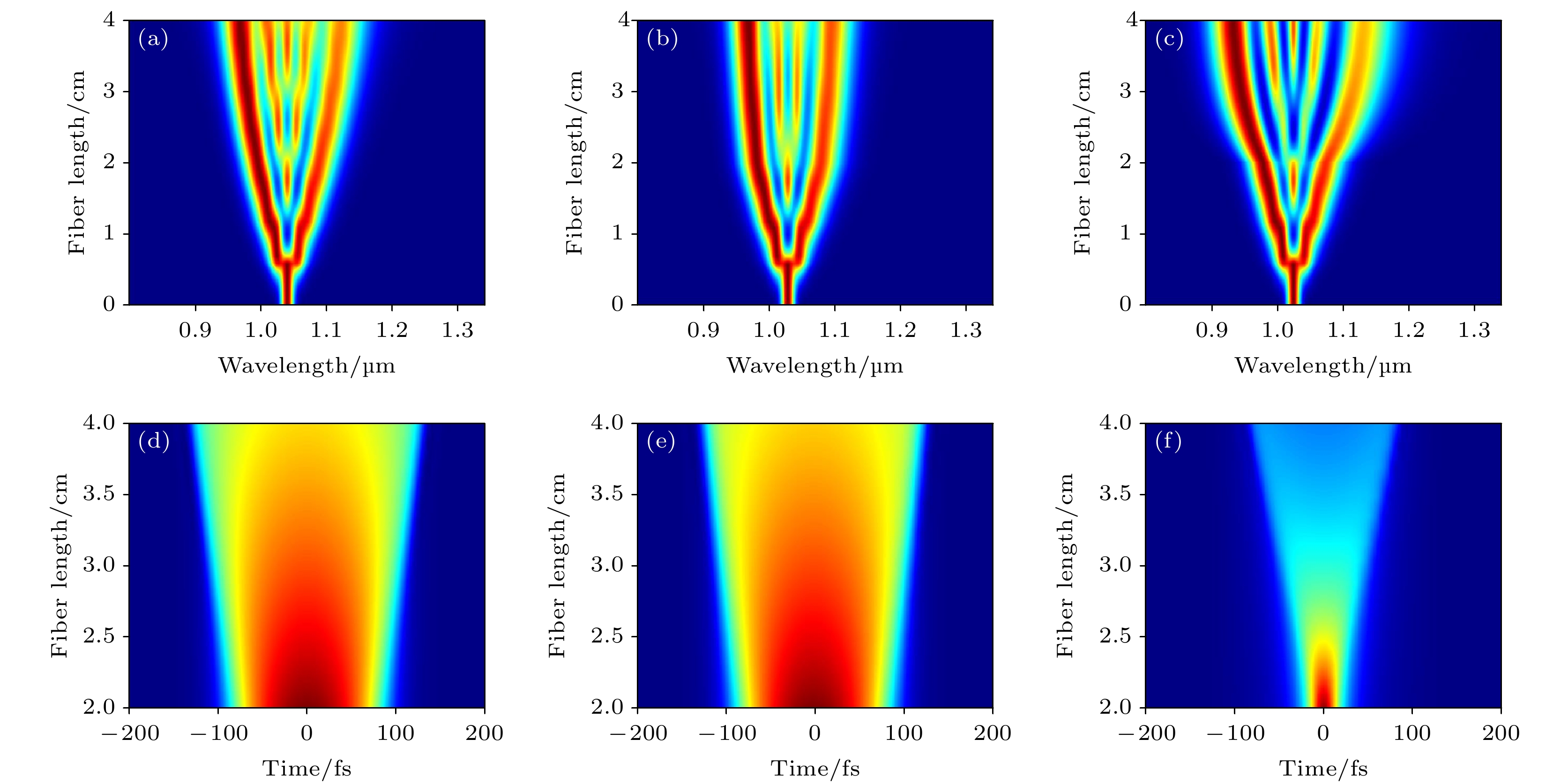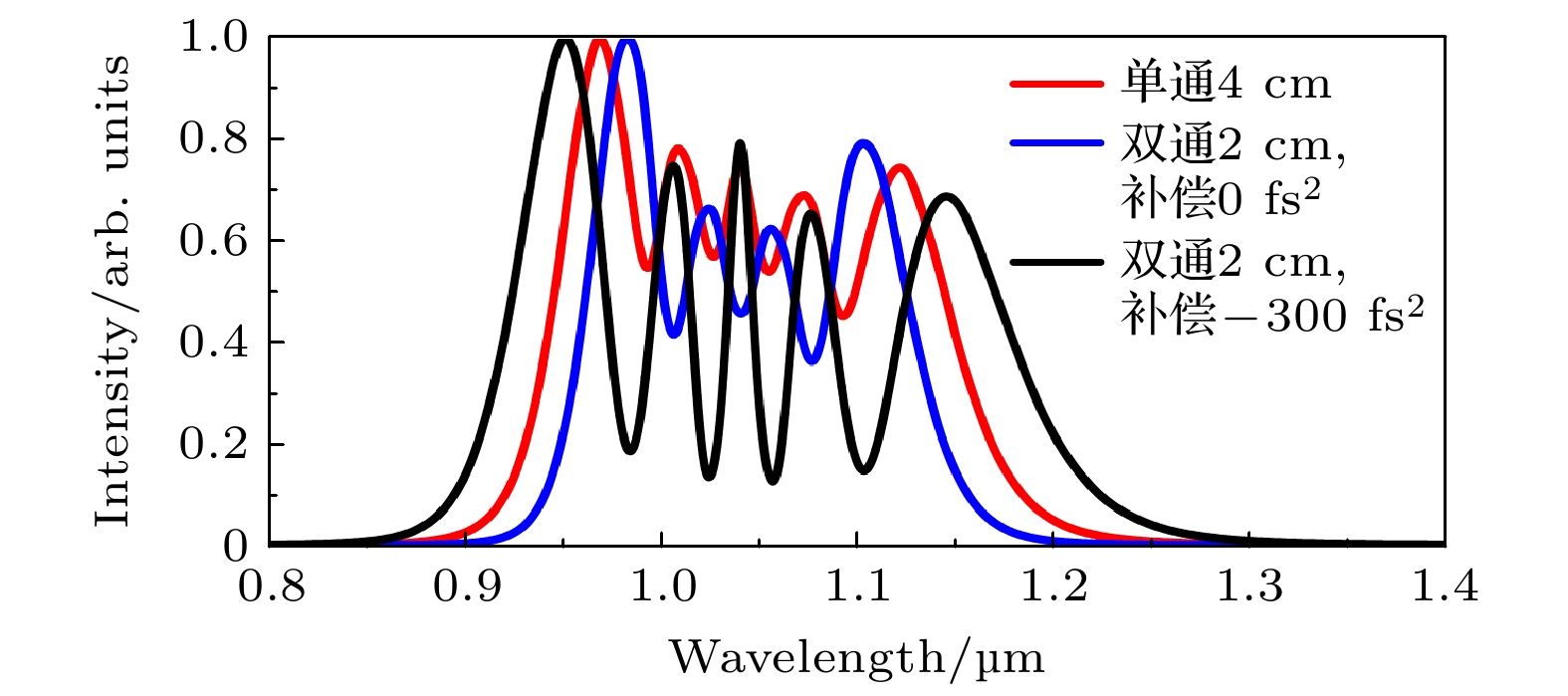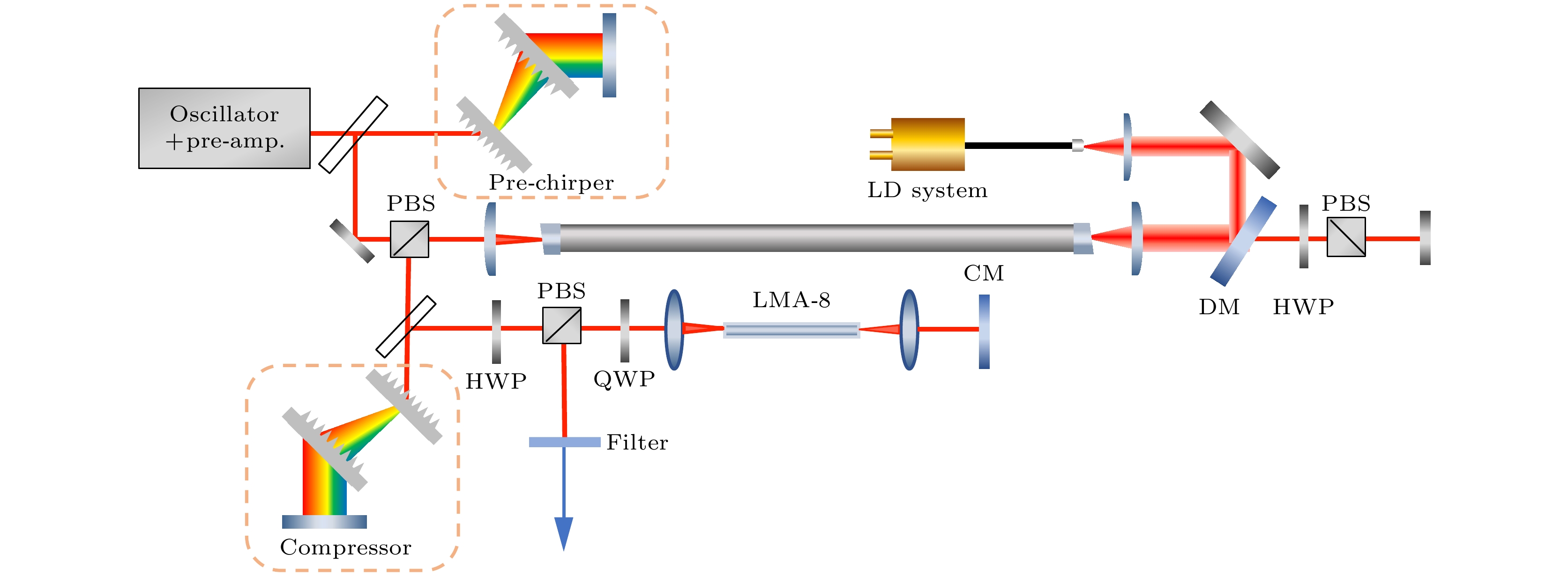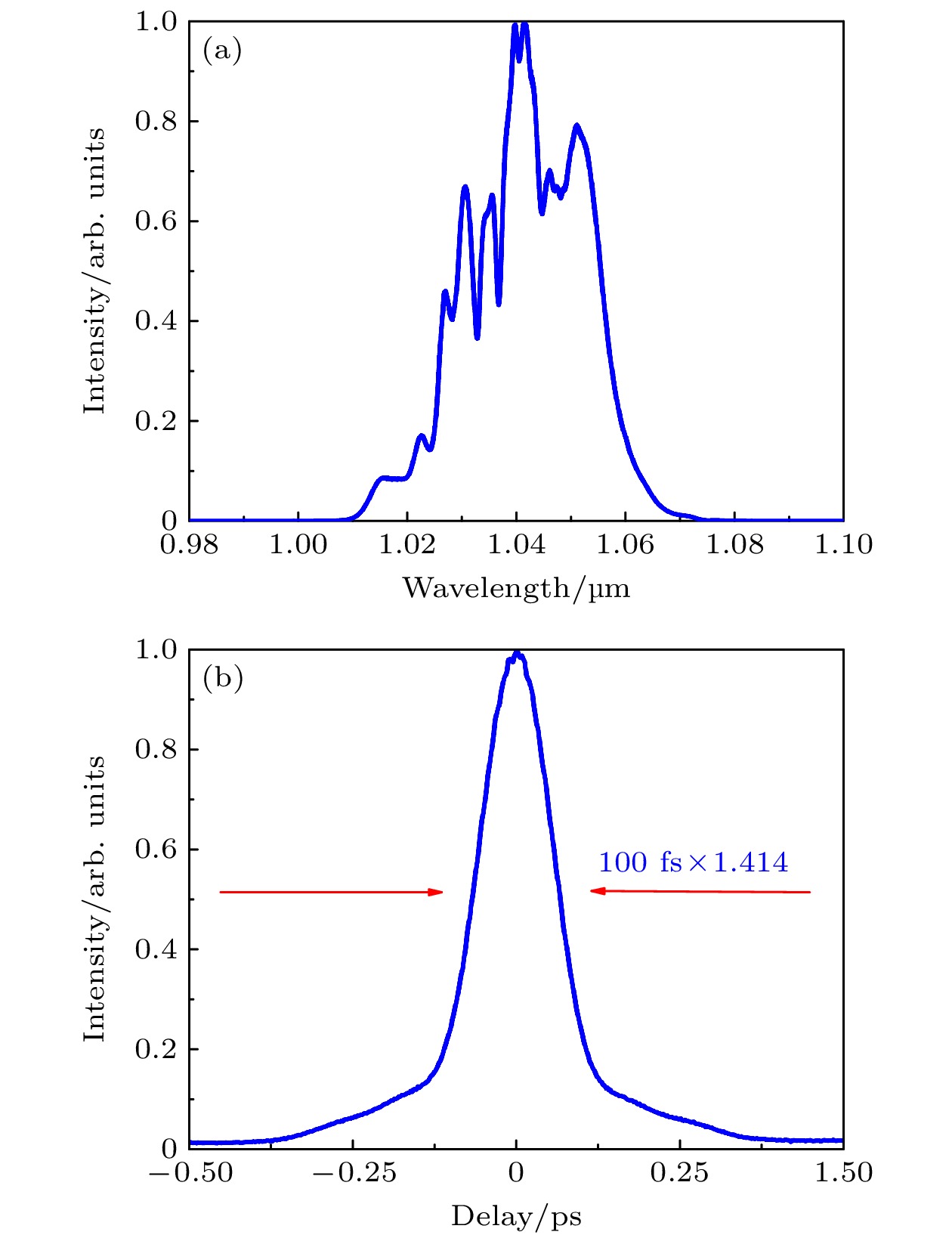-
Self-phase modulation-enabled spectral selection (SESS) technology can generate wavelength-tunable femtosecond pulses, and it is expected to replace traditional complex optical parametric oscillators, and thus has attracted much attention. However, the positive dispersion in the fiber leads the modulation depth of the spectral lobes to decrease, while optical wave breaking hinders the spectral broadening. In order to solve the two problems, we propose a dual-pass SESS technology based on dispersion management which optimizes the shape of the front edge and rear edge of the pulse prior to the second pass by introducing negative dispersion, and compresses the pulse width for increasing the peak power of the pulse. The resulting spectrum features broader spectrum with a deeper modulation depth. By numerical simulation, we find that adjusting the value of the second-order dispersion compensated after the single pass, a broader spectral lobe can be obtained than both the single-pass case and the double-pass case without dispersion compensation. To verify our numerical simulation, we conduct experiments by using a 2-cm-long LMA-8 fiber for spectral broadening and several chirped mirrors to provide negative dispersion, which controls the nonlinear evolution of the pulse in the second pass of the LMA-8 fiber. We study the spectral output corresponding to different amounts of dispersion compensation and find that an optimal dispersion value is required to produce a clear and broader spectral lobe. We also investigate the effect of input pulse energy on spectral broadening under the same dispersion compensation conditions. With 15-nJ input pulse energy and –420 fs2 dispersion compensation, the resulting SESS source delivers 6 nJ, 113-fs pulses with the peak wavelength at 920 nm.
-
Keywords:
- ultrafast fiber laser /
- self-phase modulation /
- frequency conversion
[1] Stolen R H, Lin C 1978 Phys. Rev. A 17 1448
 Google Scholar
Google Scholar
[2] Nakatsuka H, Grischkowsky D, Balant A C 1981 Phys. Rev. Lett. 47 910
 Google Scholar
Google Scholar
[3] Tomlinson W J, Stolen R H, Shank C V 1984 J. Opt. Soc. Am. B: Opt. Phys. 1 139
 Google Scholar
Google Scholar
[4] Mollenauer L F, Stolen R H, Gordon J P, Tomlinson W J 1983 Opt. Lett. 8 289
 Google Scholar
Google Scholar
[5] Her T H, Raybon G, Headley C 2004 IEEE Photonics Technol. Lett. 16 200
 Google Scholar
Google Scholar
[6] Lehneis R, Steinmetz A, Limpert J, Tünnermann A 2014 Opt. Lett. 39 5806
 Google Scholar
Google Scholar
[7] Fu W, Wright L G, Wise F W 2017 Optica 4 831
 Google Scholar
Google Scholar
[8] Buldt J, Müller M, Klas R, Eidam T, Limpert J, Tünnermann A 2017 Opt. Lett. 42 3761
 Google Scholar
Google Scholar
[9] Närhi M, Fedotov A, Aksenova K, Fiebrandt J, Schönau T, Gerecke M, Gumenyuk R 2021 Opt. Express 29 15699
 Google Scholar
Google Scholar
[10] Finot C, Fatome J 2010 Opt. Express 18 18697
 Google Scholar
Google Scholar
[11] Lin C H, Gustafson T K 1972 IEEE J. Quantum Electron. 8 429
 Google Scholar
Google Scholar
[12] Baudin K, Audo F, Finot C 2018 Microwave. Opt. Technol. Lett. 60 882
 Google Scholar
Google Scholar
[13] Liu Y, Tu H, Boppart S A 2012 Opt. Lett. 37 2172
 Google Scholar
Google Scholar
[14] Heidt A M, Hartung A, Bosman G W, Krok P, Rohwer E G, Schwoerer H, Bartelt H 2011 Opt. Express 19 3775
 Google Scholar
Google Scholar
[15] Hooper L E, Mosley P J, Muir A C, Wadsworth W J, Knight J C 2011 Opt. Express 19 4902
 Google Scholar
Google Scholar
[16] Liu W, Li C, Zhang Z, Kärtner F X, Chang G 2016 Opt. Express 24 15328
 Google Scholar
Google Scholar
[17] Chung H Y, Liu W, Cao Q, Song L, Kärtner F X, Chang G 2018 Opt. Express 26 3684
 Google Scholar
Google Scholar
[18] Hua Y, Zhou G, Liu W, Xin M, Kärtner F X, Chang G 2020 Opt. Lett. 45 3410
 Google Scholar
Google Scholar
[19] Chung H Y, Liu W, Cao Q, Kärtner F X, Chang G 2017 Opt. Express 25 15760
 Google Scholar
Google Scholar
[20] Chung H Y, Greinert R, Kärtner F X, Chang G 2019 Biomed. Opt. Express 10 514
 Google Scholar
Google Scholar
[21] Chung H Y, Liu W, Cao Q, Greinert R, Kartner F X, Chang G 2018 IEEE J. Sel. Top. Quantum Electron. 25 6800708
 Google Scholar
Google Scholar
[22] Cheng Q d, Chung H Y, Schubert R, et al. 2020 Commun. Biol. 3 569
 Google Scholar
Google Scholar
[23] Zhou G, Cao Q, Kärtner F X, Chang G 2018 Opt. Lett. 43 2953
 Google Scholar
Google Scholar
[24] Wang J, Chen R, Chang G 2022 Opt. Express 30 33664
 Google Scholar
Google Scholar
[25] 刘伟, 李中超, 陈润植, 常国庆 2023 中国激光 50 0208001
 Google Scholar
Google Scholar
Liu W, Li Z C, Chen R Z, Chang G Q 2023 Chin. J. Lasers 50 0208001
 Google Scholar
Google Scholar
[26] Liu W, Chia S H, Chung H Y, Greinert R, Kärtner F X, Chang G 2017 Opt. Express 25 6822
 Google Scholar
Google Scholar
[27] Zhang Y, Wang J, Teng H, Fang S, Wang J, Chang G, Wei Z 2021 Opt. Lett. 46 3115
 Google Scholar
Google Scholar
[28] Rothhardt J, Hädrich S, Klenke A, et al. 2014 Opt. Lett. 39 5224
 Google Scholar
Google Scholar
[29] Nagy T, Hädrich S, Simon P, et al. 2019 Optica 6 1423
 Google Scholar
Google Scholar
[30] Jenkins G W, Feng C, Bromage J 2022 Opt. Lett. 47 1450
 Google Scholar
Google Scholar
[31] Kaumanns M, Pervak V, Kormin D, Leshchenko V, Kessel A, Ueffing M, Chen Y, Nubbemeyer T 2018 Opt. Lett. 43 5877
 Google Scholar
Google Scholar
[32] Heyl C M, Seidel M, Escoto E, Schönberg A, Carlström S, Arisholm G, Lang T, Hartl I 2022 Conference on Lasers and Electro-Optics(CLEO) San Jose, California, May 15–20, 2022 pSF4E.6
[33] Omar A, Ahmed S, Hoffmann M, Saraceno C J 2021 Conference on Lasers Electro-Optics(CLEO) San Jose, California, May 9–14, 2021 pSTh2I.4
[34] Barbiero G, Wang H, Brons J, Chen B H, Pervak V, Fattahi H 2020 J. Phys. B: At. Mol. Opt. Phys. 53 125601
 Google Scholar
Google Scholar
[35] Balla P, Tünnermann H, Salman S H, Fan M, Mecejus M, Hartl I, Heyl C M 2022 Conference on Lasers Electro-Optics(CLEO) San Jose, California, May 15–20, 2022 pSM3O.1
-
图 1 (a)单通SESS与(b)色散管理双通SESS装置示意图(PBS, 偏振光束分束器; Lens, 光学透镜; HWP, 半波片; QWP, 1/4波片; CM, 啁啾镜; M, 反射镜)
Fig. 1. Schematic diagram of single-pass SESS (a) and dual-pass SESS (b) devices (PBS, polarizing beam splitter; Lens, optical lens; HWP, half-wave plate; QWP, quarter-wave plate; CM, chirped mirror; M, Mirror).
图 2 15 nJ, 100 fs脉冲在不同情况下的光谱演化曲线 (a) 情况1), 单通4 cm光纤; (b) 情况2), 通过2 cm光纤后假定脉冲能量损耗50%后, 第二次经过2 cm光纤; (c) 情况3), 通过2 cm光纤后假定脉冲能量损耗50%以及补偿–300 fs2色散后, 第二次经过2 cm光纤; (d), (e), (f) 分别对应图(a)、图(b)和图(c)最后2 cm光纤的脉冲演化图. 光纤β2 =10 fs2/mm
Fig. 2. Spectral evolution curves of 15 nJ, 100 fs pulses under different conditions: (a) Situation 1), single-pass 4 cm fiber; (b) situation 2): after passing through 2 cm fiber, assuming that the pulse energy loss is 50%, the second time passes through 2 cm fiber; (c) situation 3), passing 2 cm after the optical fiber, it is assumed that the pulse energy loss is 50% and after the –300 fs2 dispersion is compensated, it passes through the 2 cm optical fiber for the second time; (d), (e), (f) correspond to the pulse evolution diagrams of the last 2 cm fiber of panels (a), (b) and (c), respectively. Fiber β2 =10 fs2/mm.
图 3 15 nJ, 100 fs输入脉冲在光纤末端产生的输出光谱. 其中红线、蓝线和黑线分别对应单通4 cm光纤; 通过2 cm光纤后假定脉冲能量损耗50%后, 第二次经过2 cm光纤; 通过2 cm光纤后假定脉冲能量损耗50%以及补偿–300 fs2色散后, 第二次经过2 cm光纤
Fig. 3. 15 nJ, 100 fs input pulse produces output spectra at the end of the fiber. The red line, blue line, and black line represent respectively single-pass 4 cm fiber; after passing through 2 cm fiber and assuming 50% pulse energy loss, the second pass through 2 cm fiber; after passing through 2 cm fiber assuming 50% pulse energy loss and compensating for –300 fs2 dispersion, the second pass through 2 cm fiber.
图 5 20 nJ, 100 fs输入脉冲在双通2 cm LMA-8光纤后产生的输出光谱与单通补偿色散后的脉冲 (a), (c), (e), (g) 补偿0, –150, –300和–450 fs2色散后输出光谱; (b), (d), (f), (h) 单通补偿相应色散后的脉冲
Fig. 5. Output spectra generated after double-pass 2 cm LMA-8 fiber and single-pass pulse after dispersion compensation for 20 nJ, 100 fs input pulse: (a), (c), (e), (g) Output spectra after compensation of 0, –150, –300 and –450 fs2 dispersion; (b), (d), (f), (h) pulses after single-pass compensation of corresponding dispersion.
图 6 基于色散管理的双通SESS实验装置图(其中PBS, 偏振光束分束器; HWP, 半波片; QWP, 1/4波片; CM, 啁啾镜; LD, 泵浦源; DM, 双色镜; Filter, 滤光片; 其余未说明器件均为平面反射镜)
Fig. 6. Dual-pass SESS experimental setup (PBS, polarizing beam splitter; HWP, half-wave plate; QWP, quarter-wave plate; CM, chirped mirror; LD, laser diode; DM, dichroic mirror; Filter, optical filter; other unspecified devices are plane reflectors).
图 8 100 fs输入脉冲在2 cm LMA-8光纤补偿不同色散量后双通产生的光谱(此时固定输出脉冲能量15 nJ) (a), (b), (c), (d) 补偿色散量依次为0, –180, –420和–540 fs2
Fig. 8. Spectra generated by double pass of 100 fs input pulse in 2 cm LMA-8 fiber after compensating for different dispersion (the output pulse energy is fixed at 15 nJ): (a), (b), (c), (d) The corresponding compensation dispersion is 0, –180, –420 and –540 fs2, respectively.
图 10 100 fs输入脉冲双通2 cm LMA-8光纤后输出脉冲能量为15 nJ时, 利用光学滤波器滤出的最左侧光谱旁瓣和所对应的时域脉冲 (a) 滤出的光谱旁瓣; (b) 光谱旁瓣对应的脉冲自相关曲线(蓝色)以及变换极限脉冲的自相关曲线(红色)
Fig. 10. When the 100 fs input pulse double passes 2 cm LMA-8 fiber with the fixed output pulse energy of 15 nJ, the leftmost spectral sidelobe and the corresponding time domain pulse filtered out by the optical filter: (a) The filtered spectral sidelobe; (b) the pulse autocorrelation curve (blue) corresponding to the spectral sidelobe and the autocorrelation curve (red) of the transform-limited pulse.
-
[1] Stolen R H, Lin C 1978 Phys. Rev. A 17 1448
 Google Scholar
Google Scholar
[2] Nakatsuka H, Grischkowsky D, Balant A C 1981 Phys. Rev. Lett. 47 910
 Google Scholar
Google Scholar
[3] Tomlinson W J, Stolen R H, Shank C V 1984 J. Opt. Soc. Am. B: Opt. Phys. 1 139
 Google Scholar
Google Scholar
[4] Mollenauer L F, Stolen R H, Gordon J P, Tomlinson W J 1983 Opt. Lett. 8 289
 Google Scholar
Google Scholar
[5] Her T H, Raybon G, Headley C 2004 IEEE Photonics Technol. Lett. 16 200
 Google Scholar
Google Scholar
[6] Lehneis R, Steinmetz A, Limpert J, Tünnermann A 2014 Opt. Lett. 39 5806
 Google Scholar
Google Scholar
[7] Fu W, Wright L G, Wise F W 2017 Optica 4 831
 Google Scholar
Google Scholar
[8] Buldt J, Müller M, Klas R, Eidam T, Limpert J, Tünnermann A 2017 Opt. Lett. 42 3761
 Google Scholar
Google Scholar
[9] Närhi M, Fedotov A, Aksenova K, Fiebrandt J, Schönau T, Gerecke M, Gumenyuk R 2021 Opt. Express 29 15699
 Google Scholar
Google Scholar
[10] Finot C, Fatome J 2010 Opt. Express 18 18697
 Google Scholar
Google Scholar
[11] Lin C H, Gustafson T K 1972 IEEE J. Quantum Electron. 8 429
 Google Scholar
Google Scholar
[12] Baudin K, Audo F, Finot C 2018 Microwave. Opt. Technol. Lett. 60 882
 Google Scholar
Google Scholar
[13] Liu Y, Tu H, Boppart S A 2012 Opt. Lett. 37 2172
 Google Scholar
Google Scholar
[14] Heidt A M, Hartung A, Bosman G W, Krok P, Rohwer E G, Schwoerer H, Bartelt H 2011 Opt. Express 19 3775
 Google Scholar
Google Scholar
[15] Hooper L E, Mosley P J, Muir A C, Wadsworth W J, Knight J C 2011 Opt. Express 19 4902
 Google Scholar
Google Scholar
[16] Liu W, Li C, Zhang Z, Kärtner F X, Chang G 2016 Opt. Express 24 15328
 Google Scholar
Google Scholar
[17] Chung H Y, Liu W, Cao Q, Song L, Kärtner F X, Chang G 2018 Opt. Express 26 3684
 Google Scholar
Google Scholar
[18] Hua Y, Zhou G, Liu W, Xin M, Kärtner F X, Chang G 2020 Opt. Lett. 45 3410
 Google Scholar
Google Scholar
[19] Chung H Y, Liu W, Cao Q, Kärtner F X, Chang G 2017 Opt. Express 25 15760
 Google Scholar
Google Scholar
[20] Chung H Y, Greinert R, Kärtner F X, Chang G 2019 Biomed. Opt. Express 10 514
 Google Scholar
Google Scholar
[21] Chung H Y, Liu W, Cao Q, Greinert R, Kartner F X, Chang G 2018 IEEE J. Sel. Top. Quantum Electron. 25 6800708
 Google Scholar
Google Scholar
[22] Cheng Q d, Chung H Y, Schubert R, et al. 2020 Commun. Biol. 3 569
 Google Scholar
Google Scholar
[23] Zhou G, Cao Q, Kärtner F X, Chang G 2018 Opt. Lett. 43 2953
 Google Scholar
Google Scholar
[24] Wang J, Chen R, Chang G 2022 Opt. Express 30 33664
 Google Scholar
Google Scholar
[25] 刘伟, 李中超, 陈润植, 常国庆 2023 中国激光 50 0208001
 Google Scholar
Google Scholar
Liu W, Li Z C, Chen R Z, Chang G Q 2023 Chin. J. Lasers 50 0208001
 Google Scholar
Google Scholar
[26] Liu W, Chia S H, Chung H Y, Greinert R, Kärtner F X, Chang G 2017 Opt. Express 25 6822
 Google Scholar
Google Scholar
[27] Zhang Y, Wang J, Teng H, Fang S, Wang J, Chang G, Wei Z 2021 Opt. Lett. 46 3115
 Google Scholar
Google Scholar
[28] Rothhardt J, Hädrich S, Klenke A, et al. 2014 Opt. Lett. 39 5224
 Google Scholar
Google Scholar
[29] Nagy T, Hädrich S, Simon P, et al. 2019 Optica 6 1423
 Google Scholar
Google Scholar
[30] Jenkins G W, Feng C, Bromage J 2022 Opt. Lett. 47 1450
 Google Scholar
Google Scholar
[31] Kaumanns M, Pervak V, Kormin D, Leshchenko V, Kessel A, Ueffing M, Chen Y, Nubbemeyer T 2018 Opt. Lett. 43 5877
 Google Scholar
Google Scholar
[32] Heyl C M, Seidel M, Escoto E, Schönberg A, Carlström S, Arisholm G, Lang T, Hartl I 2022 Conference on Lasers and Electro-Optics(CLEO) San Jose, California, May 15–20, 2022 pSF4E.6
[33] Omar A, Ahmed S, Hoffmann M, Saraceno C J 2021 Conference on Lasers Electro-Optics(CLEO) San Jose, California, May 9–14, 2021 pSTh2I.4
[34] Barbiero G, Wang H, Brons J, Chen B H, Pervak V, Fattahi H 2020 J. Phys. B: At. Mol. Opt. Phys. 53 125601
 Google Scholar
Google Scholar
[35] Balla P, Tünnermann H, Salman S H, Fan M, Mecejus M, Hartl I, Heyl C M 2022 Conference on Lasers Electro-Optics(CLEO) San Jose, California, May 15–20, 2022 pSM3O.1
计量
- 文章访问数: 7742
- PDF下载量: 204
- 被引次数: 0













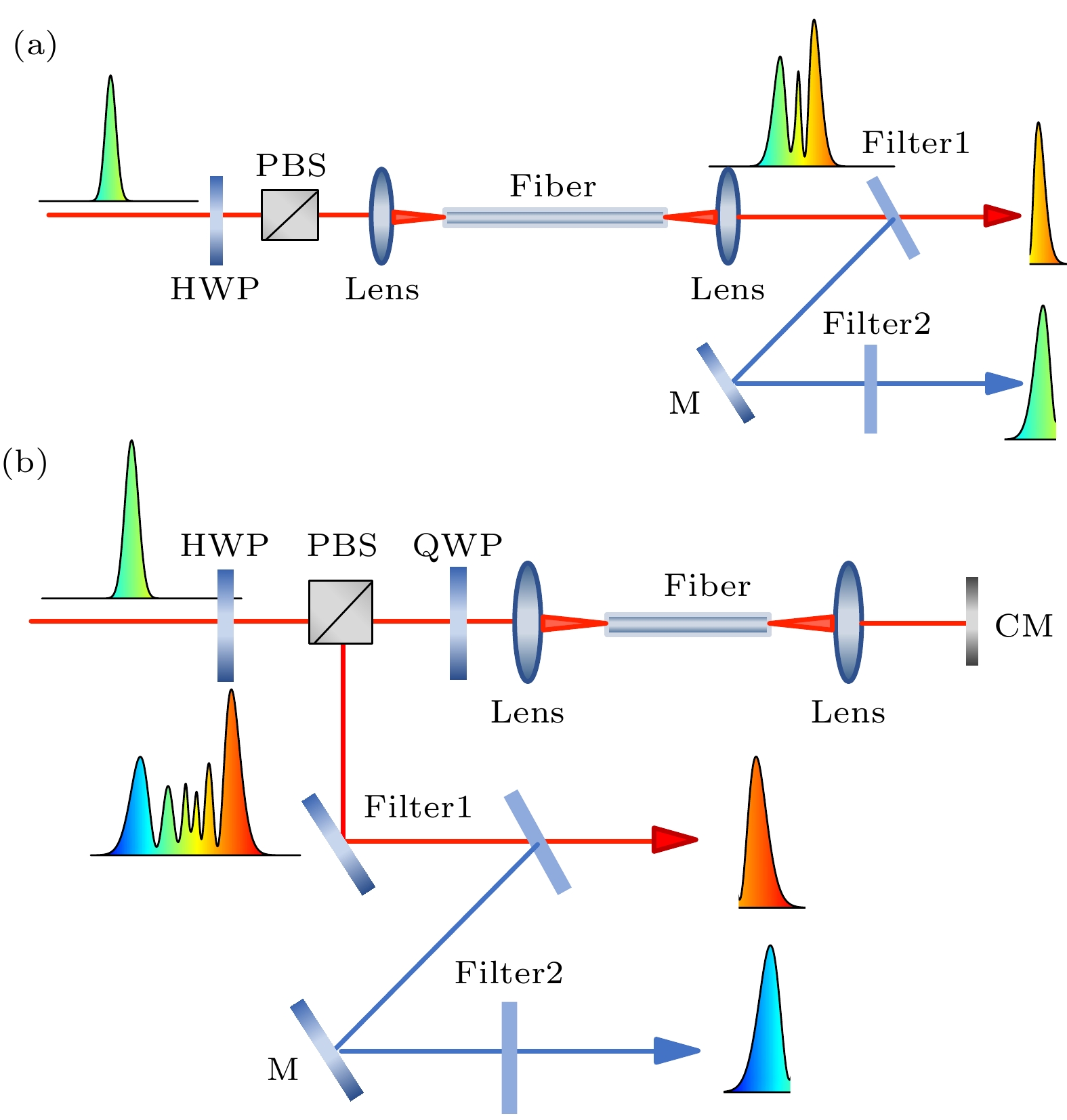
 下载:
下载:
